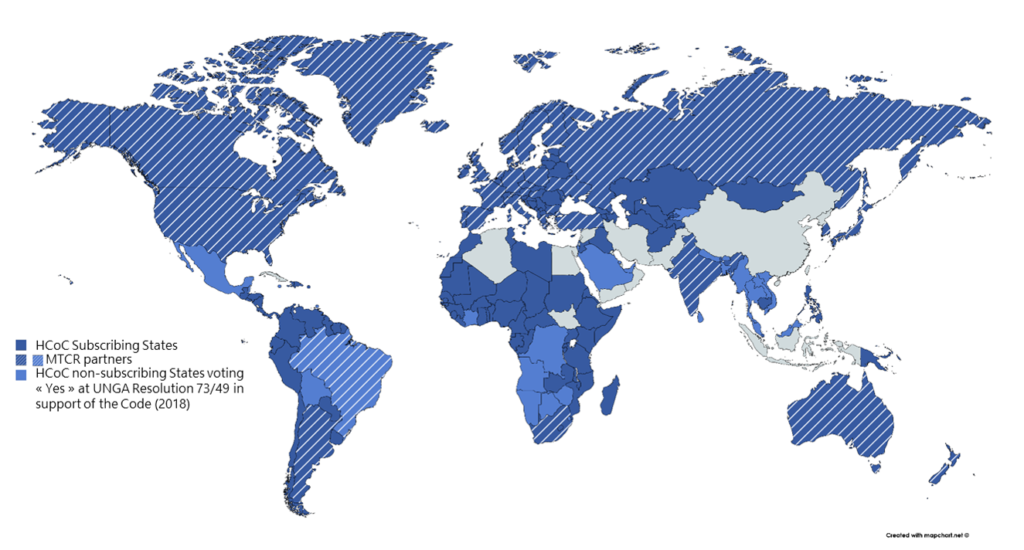
The golden decade of non-proliferation
With the end of the Cold War, a number of treaties and agreements were adopted to diminish the threat posed by nuclear weapons and drastically reduce the number of weapons deployed by the United States and Russia. This period of improved cooperation and optimism also coincided with the possibility of negotiating new non–proliferation measures and reinforcing existing ones. In particular, the international community adopted a convention prohibiting chemical weapons, extended the Non–Proliferation Treaty (NPT) indefinitely and negotiated the much anticipated Comprehensive Nuclear–Test–Ban Treaty (CTBT).
The problem of delivery vehicles and ballistic missiles had been partially addressed in 1987 with the creation of the Missile Technology Control Regime (MTCR). However, several proliferating programmes continued to emerge in the 1990s, raising major concerns. In particular, the development of a long–range ballistic missile programme in North Korea, demonstrated during an overflight of Japan in 1998, compelled the international community to confront ballistic proliferation more actively. As early as 1999, the MTCR partners collectively sought to establish a universal norm curbing the proliferation of ballistic systems.
Adopted in 2002, the HCoC was therefore a logical follow–up to the post–Cold War efforts to develop an international legal framework to fight the proliferation of weapons of mass destruction (WMDs) systems. One year after the 9/11 terror attacks and in the context of deep suspicion surrounding the proliferation activities of states such as North Korea, Libya, Iran, Syria and Iraq, the HCoC was followed by other cooperative efforts to stem the trafficking of sensitive materials (Proliferation Security Initiative, Global Initiative to Combat Nuclear Terrorism) but also legally binding instruments to limit the risks of WMDs falling into the hands of non–state actors (1540 United Nations Security Council (UNSC) Resolution).
In brief
The HCoC was adopted in 2002, at a time where the international community pushed strongly for the adoption of norms to promote non-proliferation and disarmament.
It was initially designed as a first step which would lead to further regulations in the field. However, rising international tensions have prevented states from engaging beyond the 2002 compromise.
Despite its limited scope, the HCoC has been lauded as the only universal instrument regulating ballistic missiles – an essential role given the association of ballistic systems with WMD programmes.
By focusing on confidence-building measures, the HCoC complements other regimes and norms dealing with missiles and is therefore a small yet key tool against missile proliferation.
Authors: Lauriane Héau and Emmanuelle Maitre
Creating a norm against the proliferation of WMD delivery vehicles

The HCoC has successfully created a norm which underpins the MTCR and aims at reducing the risk posed by ballistic missiles. Inspired by the then bilateral US–Soviet (and later US–Russian) launch pre–notification agreements, it has created a near–universal mechanism to avoid the misinterpretation between space launch vehicle (SLV) launches, missile tests and strikes. At a minimum, the HCoC has imposed on missile possessors a set of requirements in terms of behaviour and transparency to offset the destabilising nature of these weapons. On the non–proliferation front, the HCoC also represents a major achievement, even though it remains a non–legally binding agreement.
With the adoption of the HCoC, the international community officially stated that the dissemination of ballistic missiles coupled with WMDs is a threat to international security and as such should be curbed. The necessity for such a norm against delivery vehicles is demonstrated by the almost systematic co–development by states of WMDs and ballistic missiles. That is, all countries that have acquired nuclear, chemical or biological weapons since the end of the Cold War have also procured or produced ballistic systems, and some coupled their ballistic missiles with WMDs (Figure 1). For all except India, missile technologies and parts have been traded and transfers have occurred unimpeded by the international regimes in place. Finally, none of these states are members of the MTCR, except for India, which joined the regime in 2016.
While WMD development remains the major source of concern and in most cases constitutes a violation of international commitments, the threat of these programmes is mostly theoretical without an adequate vehicle to deliver them. Preventing the spread of ballistic missiles is therefore a practical necessity to limit the consequences of WMD programmes.

A majority of states currently agree on the desirability of curbing the dissemination of ballistic systems, even though there is no legal ban to produce or export them apart from to non-state actors and states targeted by United Nations sanctions. As such, the HCoC establishes a norm which increases the legitimacy of other initiatives aimed at curbing the dissemination of missiles capable of carrying WMDs, their technology or components. This legitimisation is emphasised by the fact that a majority of states have subscribed to the HCoC (143 in 2020), and an even greater number have voted in favour of the biennial United Nations General Assembly (UNGA) Resolution in support of the HCoC (171 in 2018).
The HCoC: a first step and a compromise
Given its limited scope, the HCoC may appear as a modest instrument to address ballistic missile proliferation. Initially designed as a first step which would then lead to more ambitious regulations, its wording reflects the political compromise made at the time of drafting the instrument:
➢ Ballistic missiles could not be simply prohibited as they were and remain used by major powers in the implementation of their nuclear deterrence strategies.
➢ A two-status treaty such as the NPT, with ‘haves’ and ‘have-nots’, was unacceptable for a majority of states.
➢ A legally binding text would have been opposed by states possessing missiles due to security concerns. As it is, some states refuse to display the level of transparency required by the HCoC.
➢ Cruise missiles or other systems used regularly on the battlefield are not included as many states would have refused to share information on their deployment or testing.
Several propositions were later made to conceive further regulations aimed at limiting ballistic missile proliferation, including additional CBM or regional measures.1 However, these hopes have not been fulfilled. The international context makes it increasingly difficult to engage states beyond the initial compromise of 2002. Complementary measures to the HCoC are somewhat unlikely to emerge in the coming years due to several challenges, including that states are increasingly relying on ballistic missiles as conventional deterrence weapons,2 that disarmament worldwide is blocked and non-proliferation objectives are challenged.
Complementarity with other instruments focusing on missiles
The adoption of the HCoC brought – for the first time – a universal focus to the problem of missiles, though other norms had previously been created to regulate these weapons to some degree. For example, bilateral arms ontrol treaties between the United States and Russia have limited the deployment of ballistic missiles and even prohibited certain categories of systems. At the national level, some states were or remain prohibited from developing ballistic capabilities because of violations of their non-proliferation commitments. For example, North Korea’s ballistic developments are prohibited by UNSC Resolution 2407.

Since it was established in 1987, the MTCR has also been an essential tool to limit the dissemination of ballistic missile technologies, parts and dual-use items. It has played a notable role in curbing the proliferation of weapon systems and roduction lines.
However, due to its nature as a voluntary export control mechanism, it remains ill-equipped to prevent the development of indigenous ballistic programmes. In 2004, UNSC Resolution 1540 brought a new dimension to WMD and delivery vehicles proliferation by focusing on non-state actors. The resolution, which addresses nuclear, radiological, chemical, biological weapons and their means of delivery, clearly underscores the destabilising effects of ballistic missiles coupled with WMD capabilities in the hands of non-state actors.

The HCoC is complementary to these efforts.3 It recalls the generally agreed principle of non-proliferation of ballistic systems and the desirability of a progressive elimination of these weapons. But in the short term, it recognises the existence of these weapons and attempts to limit their danger by defining accepted rules for those that possess them. It is underpinned by the assumption that even if eradicating an entire class of weapon systems is, for the time being, not feasible, thinking about risk reduction measures in order to lower the likelihood of such weapons being used is nonetheless worthwhile. The main tool in this regard is transparency..
About the Hague Code of Conduct
Adopted in 2002, the Hague Code of Conduct against Ballistic Missile Proliferation (HCoC) is a politically>binding instrument aiming to limit the proliferation of weapons of mass destruction (WMDs) delivery vehicles.Composed of a set of transparency and confidence-building measures, the HCoC is the only existing multilateral instrument to focus on WMD delivery vehicles. Signed by 93 states at its inception, the HCoC hasnow reached 143 subscribing states (as of December 2020).
When subscribing to the HCoC, states commit to abide by a set of UN treaties and international conventions on space security; to submit an annual declaration regarding ballistic missile capabilities and national policy on non-proliferation and disarmament treaties and instruments; and to send pre-launch notifications prior to any missile or space launch. Documents are uploaded onto a dedicated online platform (available for subscribing states only) managed by Austria, which acts as the HCoC Immediate Central Contact. Subscription to the HCoC is free of charge.
While subscribing states are asked to exercise ‘maximum restraint’ in the development of ballistic capabilities, it should be stressed that they are not proscribed from possessing ballistic missiles nor from pursuing space launch activities. Subscribing to the HCoC also enables states to gain access to information shared by other subscribing states, and to demonstrate their political commitment to non-proliferation and disarmament.
1 David Bertolotti, ’Le Code de Conduite de la Haye contre la prolifération des missiles balistiques. Le régime qui n’existait pas?’ Annuaire Français de Relations Internationales, volume VII, 2006.
2 Stéphane Delory, ‘Ballistic missiles and conventional strike weapons: Adapting the HCoC to address the dissemination of conventional ballistic missiles,’ HCoC Research Paper n°6, Foundation for Strategic Research (FRS), January 2020.
3 Kolja Brockmann, ‘Controlling ballistic missile proliferation: Assessing complementarity between the HCoC, MTCR and UNSCR 1540,’ HCoC Research Paper n°7, FRS, June 2020.





